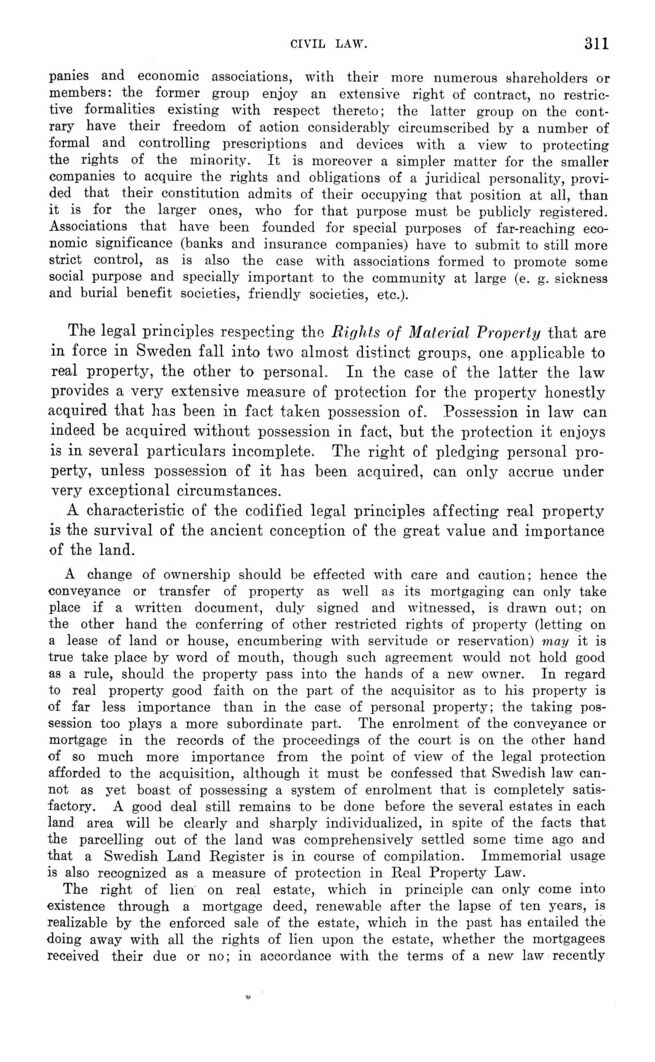
Full resolution (JPEG) - On this page / på denna sida - III. Constitution and Administration. Introd. by E. Hildebrand - 4. Legal and Judicial Organization - Civil Law. By C. G. E. Björling

<< prev. page << föreg. sida << >> nästa sida >> next page >>
Below is the raw OCR text
from the above scanned image.
Do you see an error? Proofread the page now!
Här nedan syns maskintolkade texten från faksimilbilden ovan.
Ser du något fel? Korrekturläs sidan nu!
This page has never been proofread. / Denna sida har aldrig korrekturlästs.
CIVIL LAW.
30!)
panies and economic associations, with their more numerous shareholders or
members: the former group enjoy an extensive right of contract, no
restrictive formalities existing with respect thereto; the latter group on the
contrary have their freedom of aotion considerably circumscribed by a number of
formal and controlling prescriptions and devices with a view to protecting
the rights of the minority. It is moreover a simpler matter for the smaller
companies to acquire the rights and obligations of a juridical personality,
provided that their constitution admits of their occupying that position at all, than
it is for the larger ones, who for that purpose must be publicly registered.
Associations that have been founded for special purposes of far-reaching
economic significance (banks and insurance companies) have to submit to still more
strict control, as is also the case with associations formed to promote some
social purpose and specially important to the community at large (e. g. sickness
and burial benefit societies, friendly societies, etc.).
The legal principles respecting the Rights of Material Property that are
in force in Sweden fall into two almost distinct groups, one applicable to
real property, the other to personal. In the case of the latter the law
provides a very extensive measure of protection for the property honestly
acquired that has been in fact taken possession of. Possession in law can
indeed be acquired without possession in fact, but the protection it enjoys
is in several particulars incomplete. The right of pledging personal
property, unless possession of it has been acquired, can only accrue under
very exceptional circumstances.
A characteristic of the codified legal principles affecting real property
is the survival of the ancient conception of the great value and importance
of the land.
A change of ownership should be effected with care and caution; hence the
conveyance or transfer of property as well as its mortgaging can only take
place if a written document, duly signed and witnessed, is drawn out; on
the other hand the conferring of other restricted rights of property (letting on
a lease of land or house, encumbering with servitude or reservation) may it is
true take place by word of mouth, though such agreement would not hold good
as a rule, should the property pass into the hands of a new owner. In regard
to real property good faith on the part of the acquisitor as to his property is
of far less importance than in the case of personal property; the taking
possession too plays a more subordinate part. The enrolment of the conveyance or
mortgage in the records of the proceedings of the court is on the other hand
of so much more importance from the point of view of the legal protection
afforded to the acquisition, although it must be confessed that Swedish law
cannot as yet boast of possessing a system of enrolment that is completely
satisfactory. A good deal still remains to be done before the several estates in each
land area will be clearly and sharply individualized, in spite of the facts that
the parcelling out of the land was comprehensively settled some time ago and
that a Swedish Land Register is in course of compilation. Immemorial usage
is also recognized as a measure of protection in Real Property Law.
The right of lien on real estate, which in principle can only come into
existence through a mortgage deed, renewable after the lapse of ten years, is
realizable by the enforced sale of the estate, which in the past has entailed the
doing away with all the rights of lien upon the estate, whether the mortgagees
received their due or no; in accordance with the terms of a new law recently
<< prev. page << föreg. sida << >> nästa sida >> next page >>